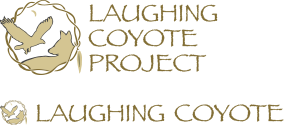
Schooling Beneath the Surface
From time to time we write articles about the Laughing Coyote Project and our programs and philosophies.
Schooling Beneath the Surface
Awakening Traditional Nature Education
By Neal C. Ritter
(Written for the Lilipoh Magazine Spring 2009)
The long fall of 2008 was a magical time as the creek was drying up on our five-acre farm. All of the life of stagnant water–bugs, snails, crawdads, algae -was concentrated into smaller and smaller areas. In the dry, crackling landscape this still, smelly water became a gold mine of adventures. The usually high number of animal tracks brought up stories of raccoons fishing for crawdads, plovers running, thirsty voles venturing down from the banks to drink: the world according to ponds. After hearing these stories, one of the students in our school -called the Laughing Coyote Project- brought a net from home. We made time to slowly, with utmost care and patience like great blue herons, wade and stalk the wonders of this grand mud puddle. With each discovery, a window was opened into a new world: colors refracting through delicately veined dragonfly wings, the nautical abilities of water striders and whirligig beetles, and we began to consider with gleeful anticipation what terrible monster was lurking within the muddy depths ready to tickle toes!
To the observer, this day of splashing and mud might seem like a classic childhood experience. But if one could listen to the instructors, one would begin to hear the constant, probing questions leading the students deeper into the world of nature, transforming this relaxed day of exploring into a profound form of education known as the Invisible School. Invisible Schooling, a learning process that mirrors indigenous mentoring practices, begins with awakening the student’s curiosity through observation and play. Then through the art of questioning, they are led along the path of their own inspiration. The term was coined by Jon Young, renowned naturalist and founder of the Wilderness Awareness School, after studying how indigenous cultures pass on their traditional knowledge without any physical school.*
In this process, the students are having so much fun, they may not realize that they are learning. This is only possible when the mentor is willing to let go of a set curriculum and work with the student. The path usually begins with a story, catching the student’s interest, an inspiring tale of someone they can admire and emulate with practice and dedication. Thus an ideal is laid out before them, and it becomes their choice to follow it. Once that choice is made, enthusiasm is infused into learning, and the mentor continues to guide them on their journey, ready to take detours peculiar to each individual student. Teaching and learning become a fluid dance, without a map. It brings out the characteristics of both the student and the mentor, where both of their interests merge, and new ideas bubble to the surface. It is an education where each day is a new adventure, and the landscape is fused with past experiences, dangers averted and future possibilities.
One of the challenges of the Invisible School is the fact that it is invisible. Learning comes so naturally that the evidence is not always apparent, and it surfaces in the most unusual way. This is a blueprint of how human beings are meant to learn.
One September morning, a mother dropped her children off late for one of our home school programs. This morning she had taken her children, ages eight and ten, to a lecture on bird migration by a local ornithologist.
“How was it?” I asked when they arrived.
“I though it was wonderful,” was her reply, “but when I asked the kids what they had learned, they said, ‘We knew it already from Laughing Coyote.’”
It amazed her because much of the material seemed very academic and far above them. In the year her children had attended our programs, we had not taught a specific class on birds or migration. In fact, we have not taught a specific class on any subject. We play games, explore the creek bed, work in the garden, and tell stories. And yet, as the students spend their days outside, they seem to naturally absorb knowledge and understanding about the ways of nature. At the Laughing Coyote Project, and many other nature-education schools, we strive to keep children’s intrinsic curiosity alive and use it as the impetus that drives the student’s learning. Children are allowed to be children, playing, building, imagining, and observing others in their community and the world. Mentors subtly guide them, using many forms of teaching, such as asking questions instead of giving answers: but as one delves into the Invisible School, one finds that there is not one set way to educate. There are as many paths as there are students and mentors.
aths as there are students and mentors.
Through looking back at the traditional roots of schooling, we can see a well-worn yet overlooked trail ahead of us. Through remembering this time-tested way of teaching, we see a revitalized relationship between children and their mentors. We see a reawakening of curiosity and inspiration. And we can rekindle a joy of learning and breathe new life into education
*Jon Young’s newest book is called Coyote’s Guide to Connecting with Nature. It can be found at: www.coyotesguide.com



